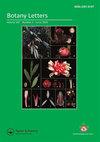Factors driving trait-convergence linked to leaf economic spectrum in tropical ferns
IF 1.3
4区 生物学
Q3 PLANT SCIENCES
引用次数: 0
Abstract
ABSTRACT Environmental filters, competition, and phylogenetic relationships play crucial roles in determining plant functional patterns across different environmental scenarios, scales, and taxa. Patterns of functional convergence and divergence are crucial to understand trait-environment interactions and plant coexistence, which must consider multiple drivers partitioning the ecological, environmental, and evolutionary processes, an integrative approach explored in this study. We analyzed leaf trait convergence and divergence among co-occurring tropical fern species, the relationship between functional and taxonomic components, and the role of local environmental conditions on functional patterns. We established 22 plots in three forest remnants of northeastern Brazil and measured key leaf economic spectrum (LES) traits (leaf area – LA, specific leaf area – SLA, leaf dry-matter content – LDMC) in fern assemblages and quantified local environmental conditions (edaphic variables, basal area of trees, and rock cover). Functional trait convergence dominated the fern assemblages for all LES traits. We found a significant phylogenetic signal for LDMC. The increases in fern species richness show an association with an increase in convergence for LA, whereas changes in fern floristic composition were associated with convergence in LDMC. Regarding the local abiotic factors, increases in soil bases and pH were related to functional convergence in LA, and soil rock cover led to a divergence in SLA. For instance, divergence in LA occurred in poor assemblages and under more acid soils, while divergence in SLA occurred in heterogeneous environments. We conclude that multiple drivers affect fern functional patterns at fine scales in the tropical forest. GRAPHICAL ABSTRACT热带蕨类植物叶片经济谱特征趋同的驱动因素
本文章由计算机程序翻译,如有差异,请以英文原文为准。
求助全文
约1分钟内获得全文
求助全文
来源期刊

Botany Letters
Agricultural and Biological Sciences-Plant Science
CiteScore
3.10
自引率
6.70%
发文量
54
期刊介绍:
Botany Letters is an international scientific journal, published by the French Botanical Society (Société botanique de France) in partnership with Taylor & Francis. Botany Letters replaces Acta Botanica Gallica, which was created in 1993, building on over a century of renowned publications by the Société botanique de France.
 求助内容:
求助内容: 应助结果提醒方式:
应助结果提醒方式:


